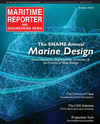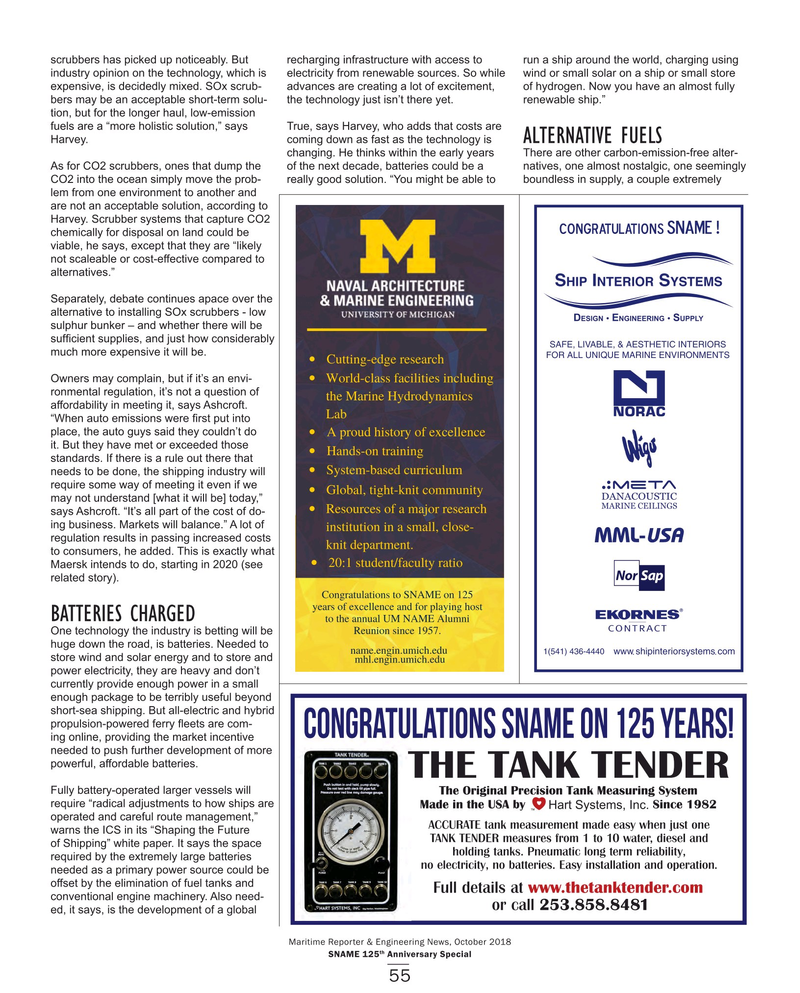
Page 55: of Maritime Reporter Magazine (October 2018)
Marine Design Annual
Read this page in Pdf, Flash or Html5 edition of October 2018 Maritime Reporter Magazine
scrubbers has picked up noticeably. But recharging infrastructure with access to run a ship around the world, charging using industry opinion on the technology, which is electricity from renewable sources. So while wind or small solar on a ship or small store expensive, is decidedly mixed. SOx scrub- advances are creating a lot of excitement, of hydrogen. Now you have an almost fully bers may be an acceptable short-term solu- the technology just isn’t there yet. renewable ship.” tion, but for the longer haul, low-emission fuels are a “more holistic solution,” says True, says Harvey, who adds that costs are
ALTERNATIVE FUELS
Harvey. coming down as fast as the technology is changing. He thinks within the early years There are other carbon-emission-free alter-
As for CO2 scrubbers, ones that dump the of the next decade, batteries could be a natives, one almost nostalgic, one seemingly
CO2 into the ocean simply move the prob- really good solution. “You might be able to boundless in supply, a couple extremely lem from one environment to another and are not an acceptable solution, according to
Harvey. Scrubber systems that capture CO2 chemically for disposal on land could be viable, he says, except that they are “likely not scaleable or cost-effective compared to alternatives.”
Separately, debate continues apace over the alternative to installing SOx scrubbers - low sulphur bunker – and whether there will be suf? cient supplies, and just how considerably much more expensive it will be.
Owners may complain, but if it’s an envi- ronmental regulation, it’s not a question of affordability in meeting it, says Ashcroft. “When auto emissions were ? rst put into place, the auto guys said they couldn’t do it. But they have met or exceeded those standards. If there is a rule out there that needs to be done, the shipping industry will require some way of meeting it even if we
DANACOUSTIC may not understand [what it will be] today,”
MARINE CEILINGS says Ashcroft. “It’s all part of the cost of do- ing business. Markets will balance.” A lot of regulation results in passing increased costs to consumers, he added. This is exactly what
Maersk intends to do, starting in 2020 (see related story).
BATTERIES CHARGED
One technology the industry is betting will be huge down the road, is batteries. Needed to store wind and solar energy and to store and power electricity, they are heavy and don’t currently provide enough power in a small enough package to be terribly useful beyond short-sea shipping. But all-electric and hybrid propulsion-powered ferry ? eets are com-
DPOHSBUVMBUJPOT4/".FPOZFBST ing online, providing the market incentive needed to push further development of more powerful, affordable batteries.
Fully battery-operated larger vessels will *'4+)+0#.4'%+5+10#0-'#574+0);56'/ require “radical adjustments to how ships are #&'+06*'$;+0%'EMLF +DUW6\VWHPV,QF ?
operated and careful route management,” $&&85$7(WDQNPHDVXUHPHQWPDGHHDV\ZKHQMXVWRQH warns the ICS in its “Shaping the Future 7$1.7(1'(5PHDVXUHVIURPWRZDWHUGLHVHODQG of Shipping” white paper. It says the space
KROGLQJWDQNV3QHXPDWLFORQJWHUPUHOLDELOLW\ required by the extremely large batteries
QRHOHFWULFLW\QREDWWHULHV(DV\LQVWDOODWLRQDQGRSHUDWLRQ needed as a primary power source could be offset by the elimination of fuel tanks and )XOOGHWDLOVDWZZZWKHWDQNWHQGHUFRP conventional engine machinery. Also need-
RUFDOO ed, it says, is the development of a global
Maritime Reporter & Engineering News, October 2018 th
SNAME 125 Anniversary Special 55
MR #10 (50-57).indd 55 MR #10 (50-57).indd 55 10/5/2018 10:44:38 AM10/5/2018 10:44:38 AM

 54
54

 56
56
